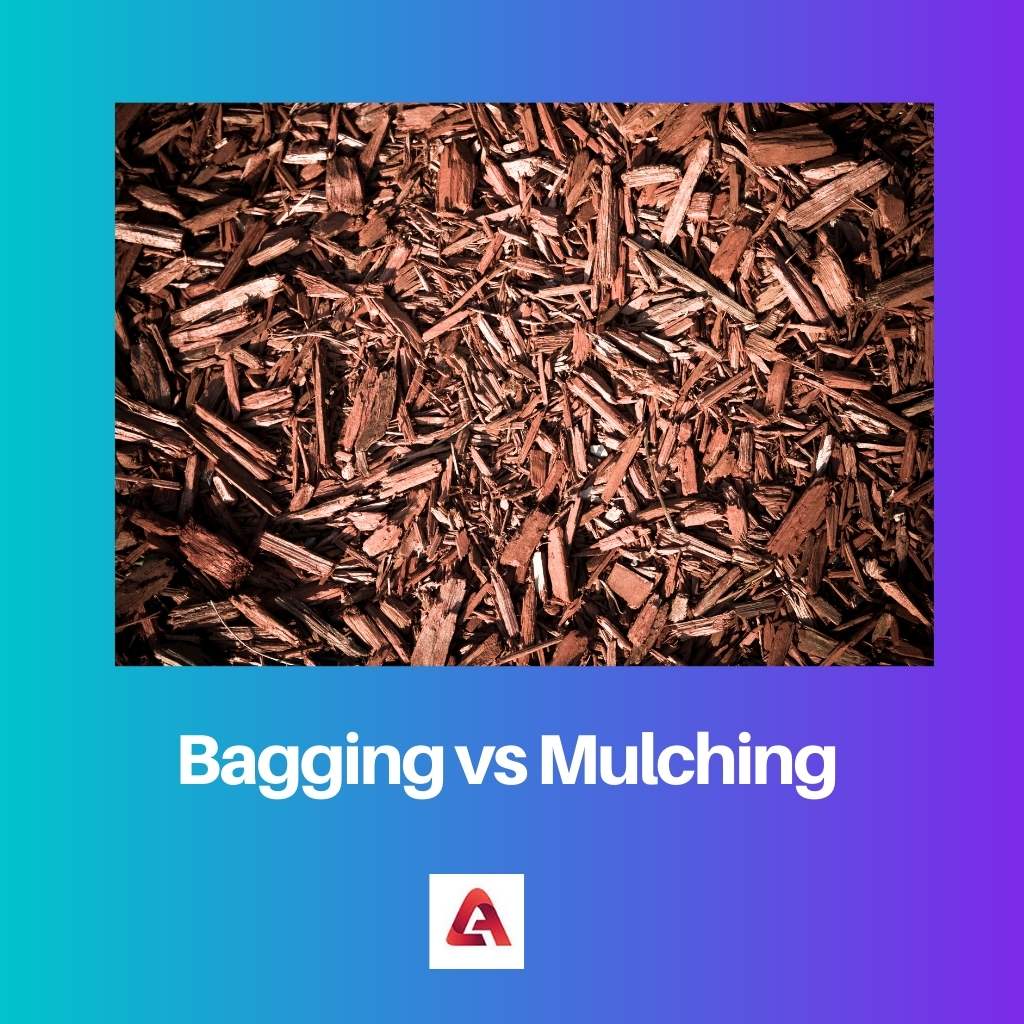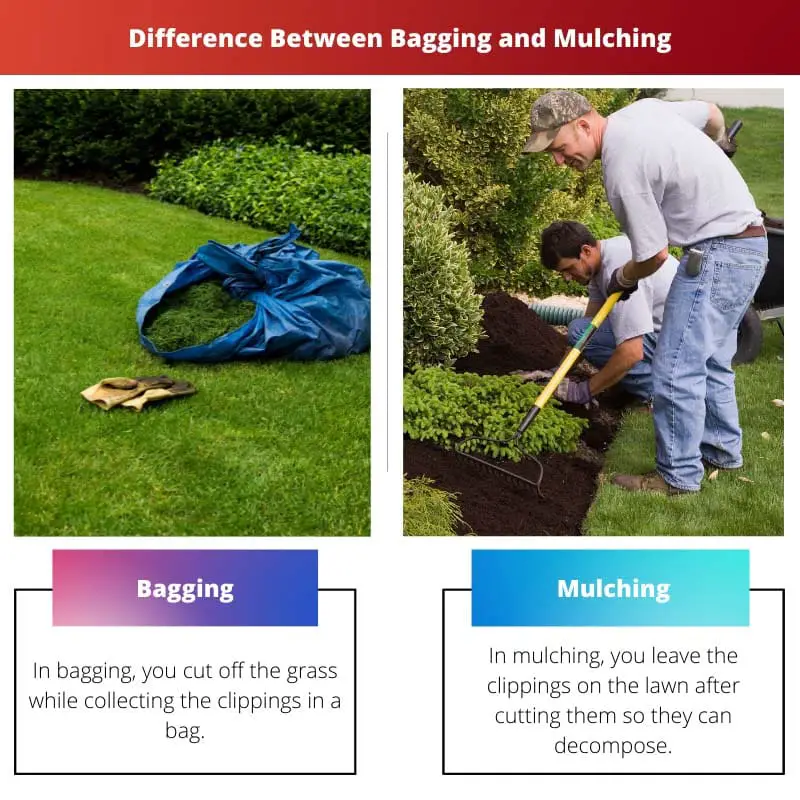There are various ways you can clean up after mowing your lawn. Some of these methods are bagging and mulching. Both of these are good in their own ways, and which one is right for you depends on your lawn needs.
Key Takeaways
- Bagging involves collecting and removing grass clippings from the lawn after mowing.
- Mulching involves decomposing grass clippings on the lawn, providing nutrients and improving soil health.
- Bagging removes grass clippings while mulching recycles them.
Bagging vs Mulching
Bagging refers to completely picking up all the clipped grass from the lawn to the disposing container. Mulching is when the grass clippings are left in the lawn for decomposing on their own in the lawn. The mulch provides important nutrients to the lawn grass after decomposing.

Through bagging, you collect the grass clippings and then get rid of them in another area to achieve a cleaner look for your lawns.
Bagging is a time-consuming process that does take up a lot of effort, but it leaves your lawn looking professional and neat.
On the other hand, through mulching, you will leave all the grass clippings in your lawn so they can turn into fertilizer that is healthier for the soil in your lawn.
However, this results in a more unkempt look. It helps you save time and requires very little effort, and it is also the more environmentally friendly option for your lawn.
Comparison Table
| Parameters of Comparison | Bagging | Mulching |
|---|---|---|
| Method | In bagging, you cut off the grass while collecting the clippings in a bag. | In mulching, you leave the clippings on the lawn after cutting them so they can decompose. |
| Time | It is time-consuming. | It saves time. |
| Health of Lawn | Bagging can help if there are any infections of weeds growing in the lawn. | Mulching helps with returning nutrients to the soil, which improves its health of the soil. |
| Convenience | It is harder for the mower. | It is convenient. |
| Sustainability | It is not environmentally friendly. | It is comparatively more sustainable. |
What is Bagging?
Experts in lawn care choose the process of Bagging to achieve a greener and cleaner look for their lawns. In Bagging, you first cut off the grass and then proceed to collect the clippings in a compost bin.
Some lawnmowers already consist of an attached dumping bag which helps in the process of bagging.
There are various pros and cons to bagging. Some of the pros include that it makes your lawn look cleaner as it is mowed and evenly cut. They give your lawn a more professional look.
Bagging also helps by making your lawn healthier. If you bag your old grass clippings, chances of diseases or fungus or any other infection are reduced. It also reduces the chances of weed growth.
Bagging results in the removal of all dead grass from your lawn which is a very good thing. If it rains, your lawn won’t uphold too much water and stay clean as no long grasses could have clogged the water.
However, there are also several cons to bagging. The biggest one would be that it can be very time-consuming. You will have to clear out the bagged clippings often, even in one mowing session, especially if you have a big lawn.
Another huge con is that when you bag the grass clippings, they consist of around 85% of water and essential nutrients, which have the potential to become natural fertilizers.
After bagging, your lawn loses all these nutrients, so you must buy fertilizers. Bagging is the less sustainable and environmentally friendly option for clearing out your lawn.
What is Mulching?
Another popular method that you can use to clean your lawn is mulching. You mow your grass to a maximum height of 3 inches in mulching.
After mowing, you leave the grass clippings exactly where they fall and let them decompose. Since grass consists mainly of water, they decompose at a fast rate.
Mulching ensures that the nutrients are returned to the soil as the organisms in the soil decompose the clippings, quickly converting them into a natural fertilizer. There are several pros and cons to mulching.
Mulching can be beneficial as it creates a nitrogen-root fertilizer for the lawn.
Another pro of mulching is that it will save a lot of time and effort, especially if you are mowing a large lawn, as you won’t need to keep emptying out your clippings.
One of the biggest pros is that it is a sustainable and earth-friendly process of mowing.
The biggest con of mulching is that it gives your lawn an amateur, chaotic, and unkempt look, as it is just the grass clippings lying about left to decompose.
Another con is that it will take a little while to decompose completely, allowing you to reap the benefits. Mulching is not ideal if you don’t cut your grass frequently.
This is because if you mow less frequently, the grass clippings will be long and be in giant chunks, which can cause the lawn to die or rot.

Main Differences Between Bagging and Mulching
- The difference between bagging and mulching is that in bagging, you collect the grass clippings in a compost bin, whereas in mulching, you leave the clippings in the lawn to allow them to decompose and become a natural fertilizer.
- Bagging is very time-consuming as you must repeatedly clear out the grass clipping. On the other hand, mulching helps save time as you leave the clippings on the lawn itself.
- When it comes to the health of your lawn, bagging will help prevent infections and diseases and also avoid the growth of any weeds. Mulching helps the health of your lawn by returning the nutrients back to the soil while acting as a natural fertilizer.
- Bagging can be inconvenient for the mower as they have to clear out the bag and throw out the clippings very frequently, whereas mulching is much more convenient.
- Bagging can be very unsustainable, whereas mulching is comparatively more environmentally friendly.





